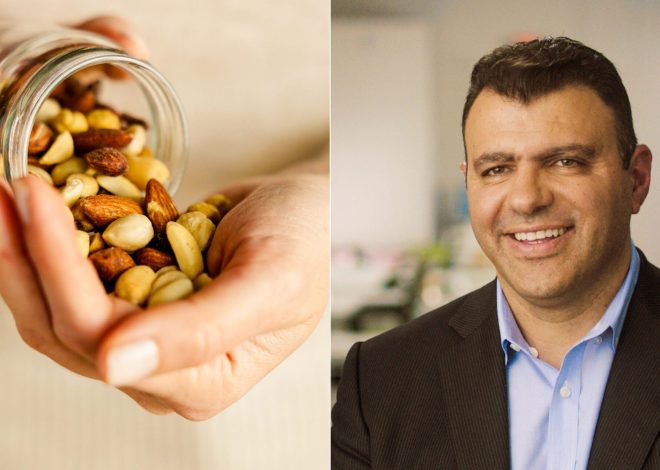
Trend researcher Tristan Horx: This is what the diet of the future will look like
In the age of social media, self-optimization is very popular among the younger generations. Those who live healthily and eat a balanced diet also look great – that’s the logic behind the phenomenon. Trend researcher Tristan Horx is convinced that the pursuit of a healthy lifestyle is no longer just about the need for recognition. In a new podcast episode of the Initiative Milch, he explains which trends will shape our relationship with nutrition today and in the future. The background to this is a new trend report that Horx and his team have produced. “The biggest trend is probably a new understanding of nutrition as a whole, which links the well-being of the planet with individual well-being,” he emphasizes in the interview.
The consumption of animal products has been declining for years, and many substitute products are coming onto the market. How does this change the supply and production of products such as cheese or sausage?
Tristan Horx: Around half of consumers use plant-based alternatives at least occasionally. The trend towards plant-based is not new and will be with us for a long time. But the taste profile and consistency of cheese, for example, are not easy to crack – with thousands of years of experience in cheese culture, the classic dairy product has an advantage here. In addition, dairy products are an important part of our gastronomic and culinary culture.
Quark, Skyr and the like are literally on everyone’s lips on social media. Why are these dairy products so popular at the moment?
Horx: This is partly due to the fitness hype. Fitness is more relevant to society than ever before… and this is where the protein boom comes into play. Proteins are the new carbs: they are important for building muscle, losing fat – in other words, everything that many people want. Quark, skyr and the like are seen by many people as interesting sources of protein.
Is it only the much-quoted Gen Z that shapes nutritional trends, or is consumption also changing among older generations?
Horx: Older people are just as interested in health issues as younger people – just in a different way. It’s less about the “30 vegan fitness challenge” and perfect abs, but more about staying healthy, prevention and – the older the audience – natural ailments. However, older generations don’t travel as much as younger ones, are less exposed to international media and have less contact with food from other cultures. Surprisingly, according to surveys, the most important value for Gen Z is health. So healthy living starts very early.
In the current podcast episode of “Let’s talk milk” you discuss current consumer trends. Which ones will have the most lasting impact on nutrition in the future?
Horx: Sustainability, animal welfare, planetary health… the biggest trend is probably a new understanding of nutrition in general, which links the well-being of the planet with individual well-being. This has many dimensions: healthy environment, healthy air in the city, health in the workplace. In this context, consumers’ desire for transparency is growing. This affects almost all areas of the food industry. In the private sector, there are now many apps that provide information when visiting the supermarket.
More and more consumers want fairly produced food. What are the drivers for this development?
Horx: Access to information is easier than ever. The new transparency has consequences: people know much more about production conditions than before. Conscience and social pressure influence consumer decisions more than they did a few years ago. Fridays for Future was an interesting turning point. Since then, the issue of responsibility has been very important and is always taken into consideration.
What role does regionality play in food consumption?
Horx: A huge role! On the one hand, we want local products, ideally knowing the farmer by name and having a webcam in the chicken coop. That makes us feel good. Many people are drawn to weekly or farmer’s markets with local products. On the other hand, we are more international than ever, and the enthusiasm for foreign cuisines and foods is enormous. The future lies in synthesis: fusing the local with the global. We call this glocalization. Regional organic yogurt plus an exotic ingredient becomes mango lassi.
The German Nutrition Society recently adjusted its recommendations. For the first time, healthy nutrition was defined not only according to health criteria, but also according to environmental criteria. How big is the influence of consumers on the environment?
Horx: The influence should not be underestimated: critical consumers bring about a lot of change. Companies have a legitimate fear of being pilloried for greenwashing and half-hearted initiatives. But the bigger lever is clearly politics. Business is ahead of politics here. For example, retail: discounters have long had their own health and animal welfare seals. Politics is lagging behind in creating conditions for farmers so that they can implement sustainable and future-proof concepts.
What trends can we already see on the horizon and what will remain the same in terms of our diet?
Horx: One important trend is towards greater transparency: about production conditions (fairer & more ethical), ingredients (cleaner) or health effects. New labels, apps and rating portals are to be expected here that respond to this consumer desire. The ongoing individualization paves the way for further differentiation of the range and more personalized offers and ensures ever new micro-trends. At the same time, dairy products will continue to be part of everyday life. Especially when a lot is changing, people tend to fall back on routines. The hype about porridge is an example of how a trend can actually be a return to something well-known.
A notice: This report is part of an automated offering from the spot on news agency, which works according to strict journalistic rules. It is not edited or checked by the AZ online editorial team. Please send questions and comments to [email protected]

Ethel Purdy – Medical Blogger & Pharmacist
Bridging the world of wellness and science, Ethel Purdy is a professional voice in healthcare with a passion for sharing knowledge. At 36, she stands at the confluence of medical expertise and the written word, holding a pharmacy degree acquired under the rigorous education systems of Germany and Estonia.
Her pursuit of medicine was fueled by a desire to understand the intricacies of human health and to contribute to the community’s understanding of it. Transitioning seamlessly into the realm of blogging, Ethel has found a platform to demystify complex medical concepts for the everyday reader.
Ethel’s commitment to the world of medicine extends beyond her professional life into a personal commitment to health and wellness. Her hobbies reflect this dedication, often involving research on the latest medical advances, participating in wellness communities, and exploring the vast and varied dimensions of health.
Join Ethel as she distills her pharmaceutical knowledge into accessible wisdom, fostering an environment where science meets lifestyle and everyone is invited to learn. Whether you’re looking for insights into the latest health trends or trustworthy medical advice, Ethel’s blog is your gateway to the nexus of healthcare and daily living.



